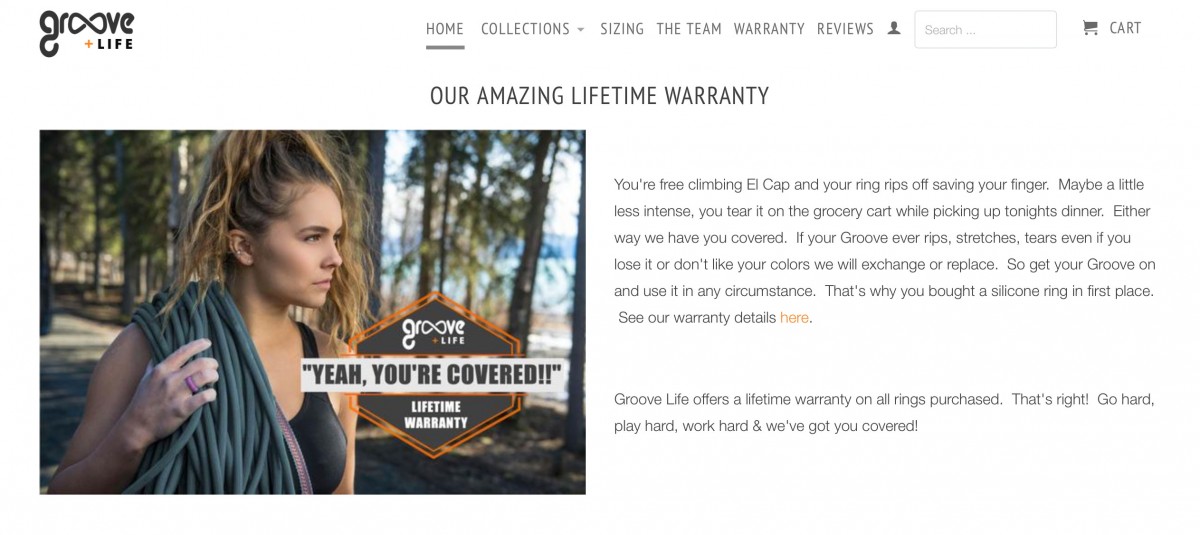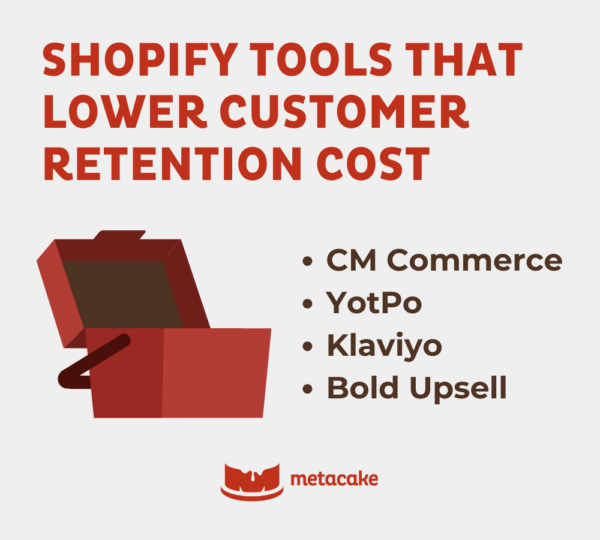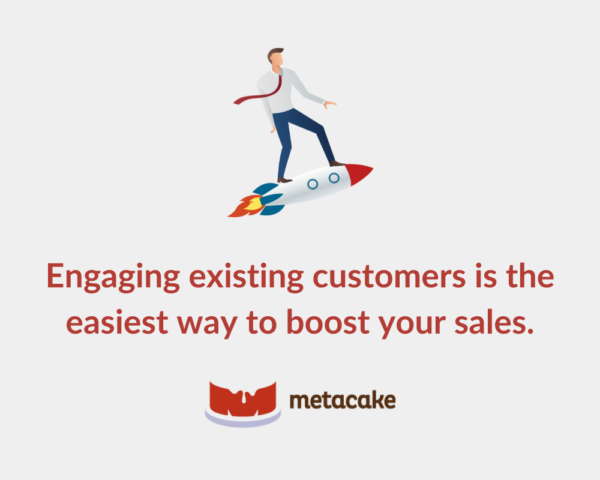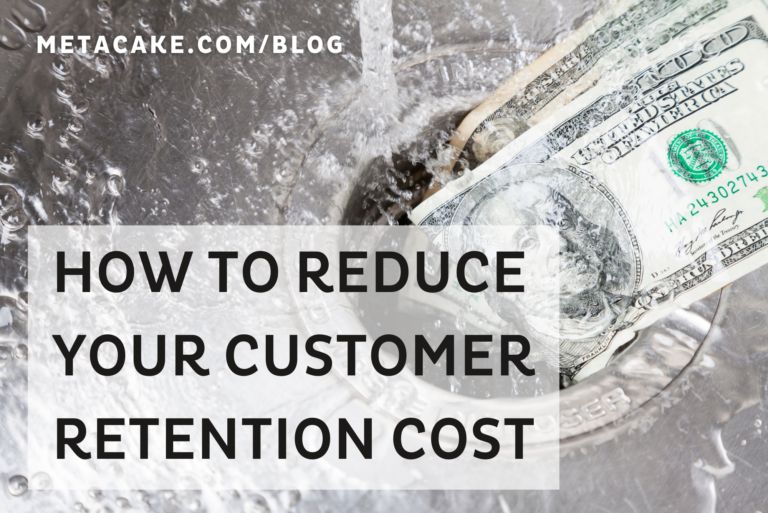Engaging existing customers is the easiest way to boost your sales.
Think about it: To acquire a new customer, you need to raise awareness about your brand, drive them to your site, build trust, and convince them to buy.
This usually doesn’t occur on a single visit. It takes tons of time and even more resources to acquire new customers.
But if your product meets your customers’ expectations, you’re well on your way to turning them not only into returning customers but also loyal fans and brand advocates.
Even if you think a customer would only buy your product once in a lifetime, don’t neglect them post-purchase. Keeping your customer retention cost low is key to sustainable growth.
For instance, take a look at our friends at Groove Life:

Groove Life’s breathable silicone rings come with a lifetime guarantee. If you ask for a replacement ring, they’ll send it to you, no matter what… which means they aren’t counting on many repeat customers.
Does that mean they ignore their customers after they purchase a ring? Absolutely not.
Groove Life creates lasting relationships with its customers by providing health and lifestyle tips post-purchase. This turns their customers into evangelists… and evangelists refer their friends. A referral is even better than a repeat customer — it’s a new customer who you don’t have to spend any money to acquire.
Today, we’ll show you how to turn current buyers into fans while keeping your customer retention cost down.
(Side note: If you’re using Shopify, you already have a leg up. Shopify includes a ton of tools you can use to build lasting relationships with your customers, so make sure you take advantage of them. We outline some specific tools below.)
How to Reduce Customer Retention Cost
Here are two simple ways to convert buyers into evangelists, get more referrals, and reduce customer retention cost:
1. Overdeliver
Provide more value than your customers expect. In the most basic sense, overdelivering creates loyal fans without increasing customer retention cost.
Providing more value than your customers expect doesn’t mean you’ll go broke. It just means your customers will feel like they’re getting more than they paid for. It has nothing to do with your true costs or bottom line.
You can overdeliver by providing excellent customer service, communicating the effort behind and quality of your products, creating free supplementary brand content that interests users, and/or surprising your customers with something extra when they open your packaging.
2. Capture Value
So, you’re delivering more value than expected and creating fans while keeping customer retention cost reasonable. How do you use this method to capture value?
First, keep in contact with buyers and provide relevant offers, including loyalty programs, upsells after the initial sale, and automated email drip campaigns to keep customers engaged after their first purchase.
Second, make it easy for fans to share information about your product. Build in easy tools they can use to share their recent purchases on social media and write reviews on your site. You can also incentivize your customers to refer your product to their friends through referral rewards programs.

Shopify Tools That Lower Customer Retention Cost
Shopify provides some great tools and apps that can help you improve customer retention through engagement. Here are our favorites:
CM Commerce (formerly Conversio)
Formerly known as Receiptful, and then Conversio, CM Commerce offers a full suite of tools that generate receipts, automate email drip campaigns, help buyers write reviews, encourage referrals, and more.
We particularly like CM Commerce’s sequence of abandoned cart follow-up emails. It makes it easy to follow up with almost-customers and convert them, reducing overall customer retention cost.
YotPo
YotPo is a program that lists customer reviews on your site, which help build trust and lower customer retention cost in the long run.
YotPo makes it easy to follow up with customers and prompt them to write a review. Upon installation, the tool reviews your last few months of orders and emails all your customers, asking them to write a review. It also sends a review request email to all new customers going forward.
YotPo’s superpower is its ease of use. Customers can write and submit their review right there in the email request — no need to jump through hoops.
Klaviyo
Klaviyo is an email marketing platform that pulls all your customer and order data — and we mean all of it. This way, you can create highly segmented email lists based on order history and customer behavior to send relevant offers to each particular customer segment.
Klaviyo allows you to send what appear to be personalized emails at scale, engaging customers and reducing customer retention cost.
Bold Upsell
With Bold Upsell, you can upsell intelligently within the checkout process, which increases the average order value of any purchase.
As long as the products you’re offering your customers are relevant to what’s already in their cart, it’s an added value to them as well. Higher order values mean you need fewer customers to hit revenue goals, lowering overall customer retention cost.
Just be sure to watch your conversion rates; if they drop after you initiate checkout upsells, you may need to test alternatives.

Reducing Your Customer Retention Cost
Reducing customer retention cost is crucial for sustainable growth and long-term success. By overdelivering on value and capturing that value through effective engagement strategies, you can turn onetime buyers into loyal fans and brand advocates.
Remember, engaging your existing customers is the most cost-effective way to increase sales and drive growth. By providing exceptional customer service, communicating your products’ value, and surprising customers with extra perks, you can create lasting relationships that lead to referrals and repeat business.
Implementing these strategies and leveraging Shopify’s nifty tools will minimize customer retention cost while maximizing each customer’s lifetime value, setting your business up for sustainable growth.
